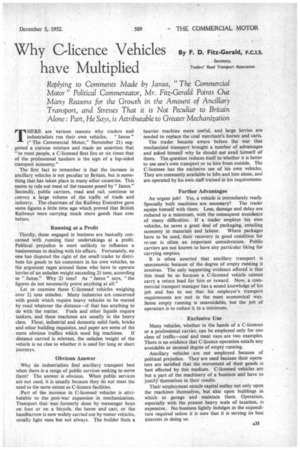Why Glicence Vehicles have Multiplied
Page 53

If you've noticed an error in this article please click here to report it so we can fix it.
By F. D. Fitz-Gerald, F.C.I.S.
Secretary, Traders' Road Transport Association
Replying to Comments Made by Janus, "The Commercial Motor" Political Commentator, Mr. Fitz-Gerald Points Out Many Reasons for the Growth in the Amount of Ancillary Transport, and Stresses That it is Not Peculiar to Britain Alone: Part, He Says, is Attributable to Greater Mechanization
THERE are various reasons why traders and industrialists run their own vehicles. " Janus " (" The Commercial Motor," November 21) suggested a curious mixture and made an assertion that "to most people, a C-licensed fleet five or six times that of the professional hauliers is the sign of a lop-sided transport economy."
The first fact to remember is that the increase in ancillary vehicles is not peculiar to Britain, but is something that has taken place in many other countries. This seems to rule out most of the reasons posed by "Janus." Secondly; public carriers, road and rail, continue to convey a large volume of the traffic of trade and industry. The chairman of the Railway Executive gave some figures a little time ago which proved that British Railways were carrying much more goods than ever before.
Running at a Profit Thirdly, those engaged in business are basically concerned with running their undertakings at a profit. Political prejudice is most unlikely to influence a businessman in dealing with his affairs. Fortunately, no one has disputed the right of the small trader to distribute his goods to his customers in his own vehicles, so the argument rages around those who have to operate lorries of an unladen weight exceeding 2+ tons, according to "Janus." Why 21 tons? As " Janus " says, "the figures do not necessarily prove anything at all."
Let us examine those C-licensed vehicles weighing over 21 tons unladen. Many industries are concerned with goods which require heavy vehicles to be moved by road whatever the distance—if that has anything to do with the matter. Fuels and other liquids require tankers, and these machines are usually in the heavy class. Flour, industrial and domestic solid fuels, bricks and other building requisites, and paper are some of the more obvious traffics which need big machines. If distance carried is relevant, the unladen weight of the vehicle is no clue to whether it is used for long or short journeys.
Obvious Answer Why do industrialists find ancillary transport best when there is a range of public services seeking to serve them? The answer is obvious. When public services are not used, it is usually because they do not meet the need to the same extent as C-licence facilities.
Part of the increase in C-licensed vehicles is attributable to the post-war expansion in mechanization. Transport that was formerly done by messenger boys on foot or on a bicycle, the horse and cart, or the handbarrow is now widely carried out by motor vehicles, usually light vans but not always. The builder finds a heavier machine more useful, and large lorries are needed to replace the coal merchant's horses and carts.
The trader became aware before the war that mechanized transport brought a number of advantages and asked himself why he should not avail himself of them. The question reduces itself to whether it is better to use one's own transport or to hire from outside. The C-licensee has the exclusive use of his own vehicles. They are constantly available to tern and him alone, and are operated by his own staff trained in his requirements.
Further Advantages An urgent job? Yes, a vehicle is immediately ready. Specially built machines are necessary? The trader equips himself with them. Loss, damage and delay are reduced to a minimum, with the consequent avoidance of many difficulties. If a trader employs his own vehicles, he saves a great deal of packaging, entailing economy in materials and labour. Where packages have to be used, their recovery in good condition for re-use is often an important consideration. Public carriers are not known to have any particular liking for carrying empties.
It is often asserted that ancillary transport is uneconomic because of the degree of empty running it involves. The only supporting evidence offered is that this must be so because a C-licensed vehicle cannot carry a return load for hire or reward. Now, a commercial transport manager has a sound knowledge of his job and has to see that his employer's transport requirements are met in the most economical way. Some empty running is unavoidable, but the job of operators Is to reduce it to a minimum.
Exclusive Use Many vehicles, whether in the hands of a C-licensee or a professional carrier, can be employed only for one class of traffic—coal and meat vans are two examples. There is no evidence that C-licence operation entails any avoidable or unusual degree of empty running.
Ancillary vehicles are not employed because of political prejudice. They are used because their operators are satisfied that the movement of their goods is best effected by this medium. C-licensed vehicles are but a part of the machinery of a business and have to justify themselves in their results.
Their employment entails capital outlay not only upon the machines themselves, but also upon buildings in which to garage and maintain them. Operation, especially with the present heavy scale of taxation, is expensive.. No business lightly indulges in the expenditure required unless it is sure that it is serving its best interests in doing so.




















































































